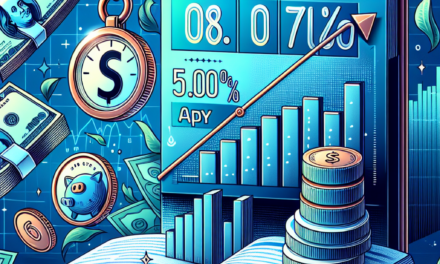“Daily Insight: Riding the Wave of U.S. Economic Momentum, the Dollar Soars.”
Introduction
Title: Daily Insight: U.S. Economic Trends Bolster Dollar’s Strength
Introduction: In recent months, the U.S. dollar has demonstrated remarkable resilience and strength, driven by a confluence of favorable economic trends. As the global economy navigates a complex landscape marked by geopolitical tensions, fluctuating commodity prices, and shifting monetary policies, the dollar’s robust performance stands out. Key indicators such as employment growth, consumer spending, and industrial output have painted a positive picture of the U.S. economy, reinforcing investor confidence and attracting capital inflows. This daily insight delves into the underlying factors propelling the dollar’s ascent, examining the interplay between domestic economic policies and international market dynamics that continue to bolster its position as a dominant global currency.
Impact Of U.S. Economic Growth On The Dollar’s Value
The recent trajectory of the U.S. economy has been a focal point for analysts and investors worldwide, as its robust growth continues to bolster the strength of the U.S. dollar. This phenomenon is not merely a reflection of domestic economic policies but also a testament to the intricate interplay of global market dynamics. As the U.S. economy expands, it exerts a significant influence on the dollar’s value, which in turn affects international trade, investment flows, and economic stability across the globe.
To begin with, the U.S. economy’s growth is underpinned by several key factors, including strong consumer spending, technological innovation, and a resilient labor market. Consumer spending, which accounts for a substantial portion of the U.S. GDP, has been buoyed by rising wages and low unemployment rates. This increase in disposable income has led to higher demand for goods and services, thereby stimulating economic activity. Moreover, technological advancements have spurred productivity gains, enabling businesses to operate more efficiently and compete effectively on a global scale.
In addition to these domestic factors, the U.S. Federal Reserve’s monetary policy plays a crucial role in shaping the dollar’s strength. By adjusting interest rates, the Federal Reserve influences borrowing costs, consumer spending, and investment decisions. In recent times, the Fed’s cautious approach to interest rate hikes has been instrumental in maintaining economic stability while preventing inflationary pressures from escalating. This prudent monetary policy has not only supported economic growth but also enhanced investor confidence in the U.S. dollar as a safe-haven currency.
Furthermore, the dollar’s appreciation is also driven by external factors, such as geopolitical uncertainties and economic challenges faced by other major economies. For instance, ongoing trade tensions and political instability in various regions have prompted investors to seek refuge in the dollar, thereby increasing its demand and value. Additionally, economic slowdowns in Europe and Asia have further accentuated the dollar’s appeal, as investors perceive the U.S. economy as relatively more stable and promising.
The implications of a strong dollar are multifaceted and extend beyond the borders of the United States. On one hand, a robust dollar benefits American consumers by making imported goods cheaper, thus enhancing their purchasing power. On the other hand, it poses challenges for U.S. exporters, as their products become more expensive and less competitive in international markets. This dynamic can lead to trade imbalances and affect the profitability of American businesses operating abroad.
Moreover, the dollar’s strength has significant repercussions for emerging markets, which often rely on dollar-denominated debt. As the dollar appreciates, the cost of servicing such debt increases, potentially leading to financial strain and economic instability in these regions. Consequently, policymakers in emerging markets must navigate the delicate balance between fostering economic growth and managing external vulnerabilities.
In conclusion, the U.S. economic growth has undeniably bolstered the dollar’s strength, with far-reaching effects on global trade and financial markets. While the benefits of a strong dollar are evident in terms of consumer purchasing power and investor confidence, the challenges it poses for exporters and emerging markets cannot be overlooked. As the global economy continues to evolve, understanding the intricate relationship between U.S. economic trends and the dollar’s value remains crucial for policymakers, investors, and businesses alike.
Key Economic Indicators Driving The Dollar’s Strength
The recent surge in the U.S. dollar’s strength can be attributed to a confluence of key economic indicators that have painted a robust picture of the American economy. As global markets navigate through a period of uncertainty, the dollar has emerged as a beacon of stability, drawing strength from a series of favorable economic data points. To understand this phenomenon, it is essential to delve into the specific indicators that have contributed to the dollar’s ascendancy.
First and foremost, the U.S. labor market has demonstrated remarkable resilience, with unemployment rates hovering near historic lows. This sustained employment strength has not only bolstered consumer confidence but has also fueled domestic consumption, a critical driver of economic growth. As more Americans find gainful employment, disposable incomes rise, leading to increased spending and, consequently, a more vibrant economy. This positive feedback loop has been instrumental in reinforcing the dollar’s position as a safe-haven currency.
In addition to the robust labor market, inflationary pressures have played a pivotal role in shaping the dollar’s trajectory. The Federal Reserve’s monetary policy, aimed at curbing inflation, has resulted in a series of interest rate hikes. Higher interest rates tend to attract foreign investment, as investors seek better returns on their capital. This influx of foreign capital has further strengthened the dollar, as demand for the currency increases in tandem with investment inflows. Moreover, the Fed’s commitment to maintaining price stability has instilled confidence among investors, who view the dollar as a reliable store of value amidst global economic volatility.
Furthermore, the U.S. economy’s resilience in the face of external shocks has underscored the dollar’s appeal. Despite geopolitical tensions and supply chain disruptions, the American economy has managed to sustain growth, albeit at a moderated pace. This resilience can be attributed to the diversified nature of the U.S. economy, which is less reliant on any single sector or trading partner. As a result, the dollar has become a preferred choice for investors seeking refuge from the uncertainties plaguing other economies.
Trade dynamics have also played a significant role in the dollar’s strengthening. The U.S. trade balance has shown signs of improvement, with exports experiencing a steady uptick. This increase in exports not only contributes to economic growth but also enhances the dollar’s value as foreign buyers convert their currencies to purchase American goods and services. Additionally, the U.S. has maintained a competitive edge in key industries such as technology and energy, further boosting its export potential and, by extension, the dollar’s strength.
In conclusion, the U.S. dollar’s recent strength is a testament to the underlying health of the American economy, as evidenced by key economic indicators such as a robust labor market, controlled inflation, economic resilience, and favorable trade dynamics. These factors have collectively reinforced the dollar’s status as a dominant global currency, attracting investors and bolstering its value. As the world continues to grapple with economic uncertainties, the dollar’s strength serves as a reminder of the enduring appeal of the U.S. economy, driven by its capacity to adapt and thrive in an ever-changing global landscape.
How U.S. Trade Policies Influence The Dollar
The strength of the U.S. dollar is a topic of perennial interest to economists, policymakers, and investors alike. As the world’s primary reserve currency, the dollar’s fluctuations have far-reaching implications for global trade and finance. One of the key factors influencing the dollar’s strength is U.S. trade policy, which plays a pivotal role in shaping economic trends. Understanding how these policies impact the dollar requires a nuanced examination of trade agreements, tariffs, and international economic relations.
To begin with, trade policies directly affect the balance of trade, which is a crucial determinant of currency value. When the U.S. exports more than it imports, there is a higher demand for dollars, as foreign buyers need the currency to pay for American goods and services. This increased demand can lead to an appreciation of the dollar. Conversely, a trade deficit, where imports exceed exports, can exert downward pressure on the dollar as more dollars flow out of the country to pay for foreign goods. Thus, trade policies that promote exports or restrict imports can bolster the dollar’s strength by improving the trade balance.
Moreover, tariffs and trade barriers are instrumental tools in U.S. trade policy that can influence the dollar. By imposing tariffs on imported goods, the U.S. government can make foreign products more expensive, thereby encouraging consumers to buy domestically produced goods. This shift can enhance the competitiveness of U.S. industries and lead to a stronger dollar. However, it is important to note that retaliatory tariffs from other countries can negate these benefits by making U.S. exports less competitive abroad, potentially weakening the dollar.
In addition to tariffs, trade agreements are another significant aspect of U.S. trade policy that can impact the dollar. Agreements such as the United States-Mexico-Canada Agreement (USMCA) or the Trans-Pacific Partnership (TPP) are designed to reduce trade barriers and facilitate smoother economic exchanges between member countries. By fostering an environment of increased trade and investment, these agreements can enhance economic growth and stability, which in turn can strengthen the dollar. Furthermore, trade agreements often include provisions that protect intellectual property rights and promote fair competition, which can attract foreign investment and further bolster the dollar.
Another critical factor to consider is the geopolitical dimension of trade policies. The U.S. often uses trade policy as a tool to exert influence on the global stage. For instance, sanctions and trade restrictions can be employed to achieve foreign policy objectives. While these measures can have short-term impacts on the dollar, their long-term effects depend on the broader geopolitical context and the responses of other nations. A stable and predictable trade policy can enhance confidence in the U.S. economy, thereby supporting the dollar’s strength.
In conclusion, U.S. trade policies are a fundamental driver of the dollar’s strength, influencing it through mechanisms such as trade balances, tariffs, trade agreements, and geopolitical strategies. As the global economic landscape continues to evolve, the interplay between these policies and the dollar will remain a critical area of focus. Policymakers must carefully consider the implications of their trade strategies to ensure that they contribute positively to the dollar’s stability and the broader economic well-being of the nation. Through a balanced approach that promotes fair trade and economic growth, the U.S. can maintain the dollar’s position as a cornerstone of the global financial system.
The Role Of Federal Reserve Policies In Dollar Appreciation

The strength of the U.S. dollar has long been a subject of global economic interest, and recent trends have underscored its robust position in the international market. Central to this phenomenon is the role of the Federal Reserve’s monetary policies, which have significantly influenced the dollar’s appreciation. As the primary institution responsible for managing the United States’ monetary policy, the Federal Reserve’s actions are pivotal in shaping economic conditions that affect the dollar’s value. By examining these policies, one can gain a clearer understanding of the factors contributing to the dollar’s current strength.
To begin with, the Federal Reserve’s approach to interest rates is a critical factor in the dollar’s appreciation. In recent years, the Fed has adopted a more hawkish stance, gradually increasing interest rates to combat inflationary pressures. Higher interest rates tend to attract foreign investment, as they offer better returns on investments denominated in dollars. Consequently, this influx of capital increases demand for the dollar, thereby bolstering its value. Moreover, the anticipation of further rate hikes often leads to speculative investments, further driving up the dollar’s strength.
In addition to interest rate adjustments, the Federal Reserve’s quantitative tightening measures have also played a significant role. By reducing the size of its balance sheet, the Fed effectively decreases the money supply, which can lead to a stronger dollar. This process involves selling off government securities, which in turn raises interest rates and reduces liquidity in the financial system. As a result, the dollar becomes more attractive to investors seeking stability and higher returns, reinforcing its appreciation.
Furthermore, the Federal Reserve’s communication strategy has been instrumental in shaping market expectations and influencing the dollar’s trajectory. Through clear and consistent messaging, the Fed has managed to maintain investor confidence and mitigate market volatility. By providing forward guidance on its policy intentions, the Fed helps market participants make informed decisions, which can lead to a more stable and predictable economic environment. This stability is often reflected in the dollar’s strength, as investors view it as a safe haven amidst global uncertainties.
It is also important to consider the broader economic context in which these policies are implemented. The U.S. economy’s relative strength compared to other major economies has contributed to the dollar’s appreciation. Robust economic growth, low unemployment rates, and strong consumer spending have all reinforced the dollar’s position. In contrast, economic challenges faced by other countries, such as slower growth or political instability, have made the dollar an attractive option for investors seeking security.
While the Federal Reserve’s policies have undoubtedly played a crucial role in the dollar’s appreciation, it is essential to recognize that these measures are part of a complex interplay of global economic forces. Factors such as geopolitical tensions, trade dynamics, and fiscal policies also influence the dollar’s value. Nevertheless, the Fed’s actions remain a central component in understanding the dollar’s current strength.
In conclusion, the Federal Reserve’s monetary policies have been instrumental in bolstering the U.S. dollar’s strength. Through interest rate adjustments, quantitative tightening, and effective communication strategies, the Fed has created an environment conducive to a strong dollar. As global economic conditions continue to evolve, the Federal Reserve’s policies will remain a key determinant of the dollar’s trajectory, underscoring their significance in the broader economic landscape.
Global Market Reactions To A Stronger U.S. Dollar
The recent surge in the U.S. dollar’s strength has captured the attention of global markets, prompting a series of reactions that underscore the interconnectedness of today’s economic landscape. As the U.S. economy continues to exhibit robust growth, driven by strong consumer spending, low unemployment rates, and resilient corporate earnings, the dollar has appreciated significantly against a basket of major currencies. This appreciation is not merely a reflection of domestic economic health but also a response to the Federal Reserve’s monetary policy stance, which has maintained higher interest rates relative to other major economies. Consequently, the dollar’s ascent has had profound implications for international trade, investment flows, and economic stability across the globe.
In the realm of international trade, a stronger U.S. dollar makes American goods more expensive for foreign buyers, potentially dampening export demand. This shift can lead to trade imbalances, as countries with weaker currencies find it more challenging to compete with U.S. products in the global marketplace. For emerging markets, which often rely heavily on exports to drive economic growth, the dollar’s strength can pose significant challenges. These nations may experience reduced export revenues, leading to slower economic growth and increased pressure on their domestic industries. Moreover, the cost of servicing dollar-denominated debt becomes more burdensome, as local currencies depreciate against the dollar, exacerbating financial vulnerabilities.
Investment flows are also influenced by the dollar’s strength, as investors seek higher returns in the U.S. market. The allure of a strong dollar, coupled with attractive interest rates, draws capital away from other regions, particularly those with lower yields. This capital flight can lead to currency depreciation in affected countries, further amplifying the challenges faced by their economies. Additionally, foreign investors may reassess their portfolios, shifting away from riskier assets in emerging markets to more stable investments in the U.S., thereby impacting global asset prices and market dynamics.
The ripple effects of a stronger dollar extend to commodity markets as well. Since many commodities, including oil and gold, are priced in U.S. dollars, their prices tend to move inversely with the dollar’s value. A stronger dollar can lead to lower commodity prices, benefiting importers but posing challenges for exporters who rely on these goods as a primary source of revenue. This dynamic can have far-reaching consequences for countries whose economies are heavily dependent on commodity exports, potentially leading to budgetary constraints and economic instability.
In response to these challenges, central banks around the world may adjust their monetary policies to mitigate the impact of a stronger dollar. Some may opt to raise interest rates to defend their currencies and attract foreign investment, while others might intervene directly in foreign exchange markets to stabilize their currency values. These policy adjustments can have varying degrees of success, depending on the underlying economic conditions and the extent of global market pressures.
In conclusion, the strengthening of the U.S. dollar is a multifaceted phenomenon with wide-ranging implications for global markets. As countries navigate the challenges posed by a robust dollar, the interplay between trade dynamics, investment flows, and monetary policies will continue to shape the global economic landscape. Understanding these complex interactions is crucial for policymakers, investors, and businesses alike, as they seek to adapt to an ever-evolving economic environment.
Comparing The Dollar’s Performance Against Other Currencies
In recent months, the U.S. dollar has demonstrated remarkable resilience and strength, a trend that has captured the attention of economists and investors worldwide. This robust performance can be attributed to a confluence of economic factors that have positioned the dollar favorably against other major currencies. As we delve into the intricacies of this phenomenon, it is essential to consider the broader economic trends that have contributed to the dollar’s ascendancy.
To begin with, the U.S. economy has shown signs of steady recovery and growth, particularly in the wake of the disruptions caused by the global pandemic. Key indicators such as employment rates, consumer spending, and industrial production have exhibited positive trajectories, thereby instilling confidence in the economic outlook. This optimism has been further bolstered by the Federal Reserve’s monetary policy, which, despite recent rate hikes, remains accommodative enough to support continued economic expansion. Consequently, these factors have collectively enhanced the appeal of the dollar as a safe-haven currency, attracting investors seeking stability amidst global uncertainties.
Moreover, when comparing the dollar’s performance against other currencies, it becomes evident that divergent economic conditions have played a significant role. For instance, the euro has faced headwinds due to sluggish growth in the Eurozone, compounded by geopolitical tensions and energy supply concerns. These challenges have exerted downward pressure on the euro, thereby widening the gap between it and the dollar. Similarly, the Japanese yen has struggled to maintain its value, primarily due to Japan’s persistent deflationary pressures and the Bank of Japan’s commitment to ultra-loose monetary policy. As a result, the dollar has gained ground against both the euro and the yen, underscoring its relative strength.
In addition to these regional dynamics, emerging market currencies have also experienced volatility, further accentuating the dollar’s dominance. Many emerging economies have grappled with inflationary pressures, exacerbated by supply chain disruptions and fluctuating commodity prices. In response, central banks in these regions have been compelled to implement tighter monetary policies, which, while necessary, have often led to capital outflows and currency depreciation. Consequently, the dollar has emerged as a preferred choice for investors seeking refuge from the uncertainties plaguing these markets.
Furthermore, the dollar’s performance has been reinforced by its status as the world’s primary reserve currency. This unique position endows the dollar with a level of liquidity and trust that few other currencies can match. As global trade and financial transactions continue to rely heavily on the dollar, its demand remains robust, further solidifying its strength in the international arena.
In conclusion, the U.S. dollar’s recent performance against other currencies is a testament to the complex interplay of economic factors that have favored its ascent. The combination of a resilient U.S. economy, divergent monetary policies, and global uncertainties has created an environment where the dollar stands out as a beacon of stability. As we move forward, it will be crucial to monitor these trends and their implications for the global financial landscape, as they will undoubtedly shape the future trajectory of currency markets. Through careful analysis and understanding of these dynamics, investors and policymakers alike can better navigate the challenges and opportunities that lie ahead.
Future Predictions For The U.S. Dollar Amid Economic Trends
The U.S. dollar has long been a cornerstone of global finance, serving as a primary reserve currency and a benchmark for international trade. Recent economic trends in the United States have further bolstered the dollar’s strength, positioning it as a formidable force in the global market. As we look to the future, several key factors are likely to influence the trajectory of the U.S. dollar, with implications for both domestic and international economic landscapes.
To begin with, the robust performance of the U.S. economy has been a significant driver of the dollar’s recent strength. Economic indicators such as GDP growth, employment rates, and consumer spending have consistently shown positive trends, reflecting a resilient economy. This economic vitality has been underpinned by technological advancements, increased productivity, and a dynamic labor market. As a result, investor confidence in the U.S. economy remains high, leading to increased demand for the dollar as a safe-haven asset.
Moreover, the Federal Reserve’s monetary policy plays a crucial role in shaping the future of the U.S. dollar. In recent years, the Fed has adopted a more hawkish stance, gradually raising interest rates to combat inflationary pressures. Higher interest rates tend to attract foreign capital, as investors seek higher returns on their investments. Consequently, this influx of capital strengthens the dollar, as foreign investors convert their currencies into dollars to take advantage of these opportunities. Looking ahead, the Fed’s policy decisions will continue to be a pivotal factor in determining the dollar’s trajectory.
In addition to domestic factors, global economic conditions also exert a significant influence on the U.S. dollar. The ongoing geopolitical tensions and economic uncertainties in various parts of the world have led to increased volatility in global markets. In such times of uncertainty, the dollar often emerges as a preferred currency due to its stability and liquidity. This flight to safety further reinforces the dollar’s position, as investors seek refuge from potential risks in other regions.
Furthermore, trade dynamics and international relations are likely to impact the dollar’s future strength. The U.S. has been actively engaged in trade negotiations and agreements, which can have far-reaching effects on currency valuations. For instance, favorable trade deals can enhance the competitiveness of U.S. exports, thereby boosting demand for the dollar. Conversely, trade disputes or protectionist measures could introduce volatility and affect the dollar’s standing in global markets.
While the current trends suggest a strong outlook for the U.S. dollar, it is essential to consider potential challenges that could alter this trajectory. Economic cycles are inherently unpredictable, and unforeseen events such as financial crises, natural disasters, or political upheavals can disrupt even the most stable economies. Additionally, the rise of digital currencies and evolving financial technologies may introduce new dynamics that could influence the dollar’s role in the global economy.
In conclusion, the future of the U.S. dollar amid current economic trends appears promising, driven by a robust domestic economy, strategic monetary policies, and global market dynamics. However, it is crucial to remain vigilant and adaptable to changing circumstances that could impact the dollar’s strength. As the world continues to navigate an increasingly complex economic landscape, the U.S. dollar is likely to remain a central player, shaping the course of international finance for years to come.
Q&A
1. **What is the current trend of the U.S. dollar?**
The U.S. dollar is currently strengthening.
2. **What economic factors are contributing to the dollar’s strength?**
Strong economic growth, low unemployment rates, and rising interest rates are contributing to the dollar’s strength.
3. **How are interest rates affecting the dollar?**
Rising interest rates are attracting foreign investment, thereby increasing demand for the dollar.
4. **What impact does the dollar’s strength have on U.S. exports?**
A stronger dollar makes U.S. exports more expensive and less competitive abroad.
5. **How does the dollar’s strength affect inflation?**
A stronger dollar can help reduce inflation by making imports cheaper.
6. **What sectors benefit from a strong dollar?**
Sectors that rely on imports, such as retail and manufacturing, benefit from a strong dollar due to lower import costs.
7. **What are the potential risks of a strong dollar?**
Potential risks include reduced export competitiveness and potential trade imbalances.
Conclusion
The conclusion of the “Daily Insight: U.S. Economic Trends Bolster Dollar’s Strength” is that recent positive economic indicators in the United States, such as robust job growth, increased consumer spending, and rising interest rates, have contributed to the strengthening of the U.S. dollar. These factors enhance investor confidence and attract foreign investment, further solidifying the dollar’s position in global markets. However, the sustained strength of the dollar may also pose challenges for U.S. exporters by making American goods more expensive abroad, potentially impacting trade balances. Overall, while the current economic trends support a strong dollar, careful monitoring of potential inflationary pressures and international trade dynamics is essential.





